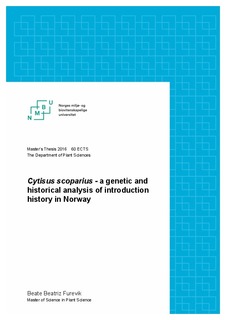Cytisus scoparius : a genetic and historical analysis of introduction history in Norway
Abstract
Cytisus scoparius is an invasive species threatening the local flora where the shrub is introduced. Studies show that the shrub spreads rapidly and has damaging effects in areas where the plant is considered invasive. Cytisus scoparius has been considered native in Norway but may threaten vulnerable habitats such as coastal heathlands, calling for a regulation of the shrub’s expansion. This study uses molecular and historical analysis to investigate if in fact C. scoparius is native to the Norwegian flora or if it is introduced through human actions. 28 Norwegian C. scoparius populations were sampled and compared with 27 non-Norwegian samples and 22 Norwegian herbaria samples. The samples were grouped into nine haplotypes and analyzed to find if there is a genetically distinct variation of C. scoparius in Norway, and to decide whether there has been a single or multiple introductions to Norway, and if there is a traceable introduction path. My results reveal high genetic variation among all samples. The nine haplotypes identified are scattered over a large area, which indicates multiple introductions to Norway and makes it difficult to trace possible introduction routes.
